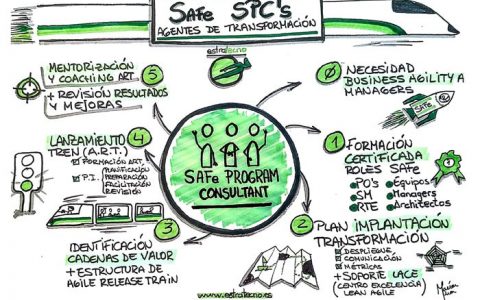

Certified Scrum Master (CSM)
A highly interactive course that teaches in-depth the Scrum framework fundamentals, and how to implement Scrum within an organization to achieve success.
Introduction
This is an official course that will provide you with a basic survival guide to become a good Scrum Master with a solid understanding of Scrum Framework and its implementation, and it will prepare you to take the CSM exam. And in case you are just curious about agile and the tools you may use for adopting it in your environment, this is also a good course to start with.
You will get countless valuable tips on how to interact with the Scrum Teams, understand the basics and good practices to ensure a greater probability of overall success on the different product/project types, sizes and sectors you may work in.
You will be "learning by doing"; your trainer/s will reinforce and ensure the understanding of Scrum, its cycle and elements as well its fundamental values and principles by interactive and dynamic group exercises.
The official Scrum Alliance Certified Scrum Master (CSM) certification exam is included in the price.

- Professionals who are already Scrum Masters or will become one in the future, and are interested in earning a certification of great international recognition.
- Agile Coaches.
- Developers.
- Product Owners.
- Project Managers, architects, engineers, consultants and other professionals who are interested in learning and understanding one of the most widely used agile frameworks.
- Syllabus structured and adapted to the Scrum Alliance requirements for official courses.
- Preparation and eligibility to take the Scrum Alliance Scrum Master certification exam.
- Understand the origins of agile and the main differences with the predictive models (waterfall).
- Understand the Agile Manifesto and its values and principles.
- Scrum Values and Principles to implement an agile culture.
- How to become a Change Agent and how to trigger and take part in the organizational transition.
- Be able to describe Scrum correctly with your own words.
- Become familiar with the Scrum implementation in non-IT environments.
- Understand each element of the Scrum Framework, its purpose, interactions, and where commonly used good practices and tools fit in.
- Understand the Scrum roles, their main responsibilities, accountabilities, competencies and characteristics.
- Do a self-assessment to evaluate yourself as a Scrum Master and get tips for self-improvement.
- Identify and solve the main challenges for the use of Scrum.
- Learn how to search for information and experiment with the potential of the communities of practices.
- Become familiar with the Scrum Master’s schedule for a two-week sprint.
- Evaluate if Scrum is the right framework for your product, project and/or organization.
- Understand the Scrum Events, their purpose, structure, inputs and outputs and how they are related with the Scrum Roles.
- Understand the Scrum Artifacts, their characteristics, commitments and how they are related with the Scrum Events and Roles with a fun and creative exercise called Scrum Master Chef.
- Live virtual classroom.
- Expert trainers and facilitators in online training.
- Breakout rooms for teamwork.
- Virtual Campus with LMS (Learning Management System) platform for the course material, tests, forums, and complementary materials.
- Collaborative tools for exercises and practices such as Mural.
The course includes exercises and dynamics based on “learn by doing” so that the attendees, apart from being able to internalize the framework, the cycle, the elements and the practices of Scrum, will have a solid foundation and will learn a technique that will be very useful for Scrum Masters.
Before the class
We provide to the attendee access to the Virtual Classroom where all the live videoconference sessions with the CST® (Certified Scrum Trainer) are available, as well as official course material, additional material, and reading recommendations.
During the course
The attendee will use tools (Mural and/or similar) to co-create digitally part of the course content. The attendee will learn not only from the experience of the trainer/s but also from the rest of the attendees interacting with as a group. Practice and discussions in pairs and/or groups about different topics will help the attendee to internalize concepts and maximize understanding of Scrum. The practices are carried out in breakout rooms to enhance the group member interaction. The attendee will have a period of 30 days to download all the course material (the one created during the course, boards, any other official material…)
The infrastructure, tools and platform are provided by Estratecno. Having a stable and high-speed internet connection and a computer with a microphone and a camera is enough.
CSM Certification Exam
Once the attendee has completed the course with the minimum required attendance hours (actually it is 14 hours for this course), s/he will receive an e-mail from Scrum Alliance with the information needed to access the Scrum Master certification exam which is included in the price.
The exam is online and has a total of 50 multiple-choice questions. The student that answers 37 questions correctly will obtain the Certified Scrum Master certification, which also includes two years of Scrum Alliance membership.
- 16 hours of official training: The attendee will obtain a deep understanding of the Scrum Framework, learn how to apply it in his/her teams and organization to help them be successful, and be prepared for the official Scrum Master certification exam.
- Certification: Scrum Alliance Certified Scrum Master (CSM) certification upon passing the exam.
- Very practical training material to maximize the attendees learning, knowledge and understanding by creating small communities and working groups between them.
- Scrum Alliance membership for 2 years.
Following the structure guideline required by Scrum Alliance
Introduction to Agile
- What its origin is? What are its main characteristics?
- The Agile Manifesto, its values and principles
- Differences between agile and waterfall
- Analyze the application of agile values in your environment
- How to improve the organizational agile transition?
- The Cynefin Framework
- Success rates comparison according to project size and the applied project management
Introduction to Scrum
- Definition of Scrum
- The Flow in Scrum
- Scrum success stories
- The Scrum Framework
- The Scrum Cycle
Roles
- The Scrum Team
- What responsibilities and accountabilities does the Scrum Team have and how are distributed between the roles? Main features and recommendations
- The Product Owner
- The Developers
- The Scrum Master
The Scrum Master
- Scrum Master Self-Assessment
- Tips to improve as a Scrum Master
- Challenges of each role
- Tips and ideas to overcome the challenges
- The day-to-day of a Scrum Master
The Scrum Events
- The Scrum Team Calendar
- What are the Scrum events and why do we have them? Their structure, objectives, attendees, inputs and outputs, recommendations and the key points
- The Sprint
- The Sprint Planning
- The Daily Scrum
- The Sprint Review
- The Sprint Retrospective
The Scrum Artifacts
- The Product Backlog
- What is it and what is it for? Characteristics, content (PBI), objective and the Product Goal as the commitment
- The Sprint Backlog
- What is it and what is it for? Characteristics, content and the Sprint Goal as the commitment
- Recommendations on how to create and maintain a Sprint Backlog
- The Increment and the Definition of Done
- The artifacts in the Scrum cycle
Everyone is welcome to attend the course, regardless of their experience.
- Format: Web-based, timed online exam with multiple choices
- Access: Through the Scrum Alliance Platform after the attendee has completed the CSM course with the minimum required attendance
- Duration: 60 minutes
- Number of questions: 50
- Passing score: 37 out of 50 which is 74%
- Language: Spanish/English/and others
- Number of attempts: 2



